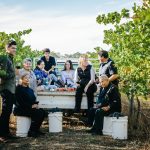Image: NWGIC researchers Dr Celia Barril, Professor Chris Steel, Associate Professor Paul Prenzler, Dr John Blackman, Dr Andrew Clark and Associate Professor Sandra Savocchia celebrate the graduation of Dr Dilhani Peera (front).
The National Wine and Grape Industry Centre (NGWIC) has celebrated the achievements of two PhD graduates who’ve been presented with their awards by Charles Sturt University, after 2020 graduation events were postponed by COVID-19.
The Centre’s Dr Dilhani Perera Dawatage and Dr Xinyi Zhang were among the 600 Charles Sturt graduates recognised in formal ceremonies in Wagga Wagga recently.
The NWGIC is an alliance between Charles Sturt, the NSW Department of Primary Industries and the NSW Wine Industry Association.
Dr Dawatage’s research has added to the understanding of the impact fumonisins, a group of mycotoxins produced by the fungus Aspergillus when it infects grapes.
“Aspergillus rot is one of the several fungal bunch rot diseases found in grapes which can result in yield losses, particularly in seasons with high rainfall,” Dr Dawatage said.
“The main focus of my PhD research was to identify the risk associated with fumonisins for grapes and wine industries.”
From 38 Aspergillus isolates collected from Australian vineyards, Dr Dawatage found six produced fumonisins.
She studied the effects of temperature and water activity for fumonisin production by Aspergillus, the fate of fumonisins during wine making process and the effects of fining agents on the removal of fumonisins in wine.
Dr Dawatage said more research is needed to understand the occurrence of fumonisins in grapes under field conditions.
However, she said the results from her study suggest that the risk associated with fumonisins for the Australian grape and wine industry is likely to be minimal.
“I hope my research will help develop strategies to minimise the exposure to fumonisins through consumption of grape and grape products,” she said.
Dr Zhang has been awarded her PhD for research investigating the reductive and oxidative compounds that contribute to off- flavours in wine.
Specifically she examined low molecular weight sulfur compounds (LMWSCs) and volatile aldehyde compounds (VACs) and their accumulation during wine production and maturation.
As part of the research, two new techniques were validated to allow improved quantification of total VACs concentrations in wine.
Dr Zhang also studied the potential linkage between specific viticultural conditions and wine composition and bottle ageing, with a focus on the accumulation of reductive and oxidative off-flavours related compounds.
She found clear evidence that copper (Cu) and sulfur dioxide (SO2) additions to juice and must can impact volatile sulfur and aldehyde compounds during wine production and even after 15-months of bottle ageing.
Dr Zhang said the research also assessed the impacts of viticultural factors on wine aging.
“The experiment assessed vineyard location, grape variety and grape maturity, four bottle ages (0, 8, 16 and 24 months), and three different levels of oxygen availability during bottle ageing on Shiraz and Cabernet Sauvignon wine composition
“I tracked the evolution of 82 wine composition related parameters over the two years, using a variety of chemical and statistical (chemometric) analysis.
“Each viticultural factor and bottle ageing condition was able to be distinguished but the influences from viticultural factors were more decisive.
“These may lead to potential markers in wine for the specific viticultural conditions used in grape production,” Dr Zhang said.
Are you a Daily Wine News subscriber? If not, click here to join our mailing list. It’s free!
















